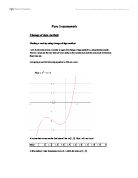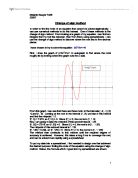I am going to use the equation:
y = 5x3+4x2-7x-4
The graph of the equation is shown below:
By doing an initial search using the equation, I have found three main intervals where there is a change of sign.
The change of signs are in the intervals [-2, -1], [-1,0] and [1,2].
To demonstrate the method, I am going to find the root in the interval [1,2].
The above table shows that there is a change of sign between 1.1 and 1.2. Therefore, we now know that the root lies in the interval [1.1,1.2]
We can extend the search further to find the interval of the change of sign with greater accuracy.
The table shows a change of sign between 1.11 and 1.12. The root is in the interval [1.11,1.12]
This table now shows that the root is in the interval [1.11,1.111].
Error Bounds
X=
Failure of the Change of Sign Method
Although the Change of Sign method has been proved to work above, there are many examples of cases or equations which would be wrongly represented by this technique. Examples of these are shown below:
-
Repeated Roots - in an initial search using the Change of Sign method, the table of values for an equation such as y = (x-1.26)2 (x+1.4) would overlook the second root. As you can see from the graph below, there are two roots; one in the interval [-2,-1] and one in the interval [-1,0]. However, the table only shows one change of sign in the interval [-2,-1].
2. The Change of Sign Method would also fail with an equation where all of the roots fall within the same interval, such as in the equation y = x3-1.7x2+0.84x-0.108. The table below shows only one change of sign in the interval [0,1]. This would indicate that there is only one root, rather than three, in this interval.







